AMD vs. Intel: Battery Life Investigated
by Jarred Walton on August 5, 2009 5:00 PM EST- Posted in
- Laptops
Laptops: Comparing Apples to Apples
Anyone looking to go out and purchase a new laptop is almost certainly interested in a couple things: how much does it cost, and what sort of battery life can you expect? Answering those questions for any specific laptop is simple enough, provided we can get a sample unit for testing. However, it becomes more difficult to answer these questions when you're looking at the big picture -- i.e. AMD vs. Intel laptops. The pricing question is easier: laptops using AMD platforms are (usually) cheaper than equivalent Intel platform laptops. That's simple enough: you're paying more for the Intel brand. But what about battery life?
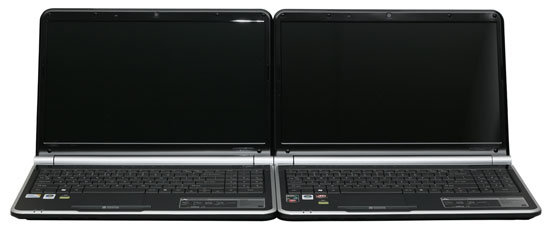 |
We have long tried to answer that question, but the best we could do up until this point was to compare "similar" laptops. Getting the same LCD, hard drive, optical drive, and most importantly battery has been very difficult -- so difficult that we have not been able to do it. A few manufacturers offer competing AMD and Intel laptops with very similar specifications, but no one seemed willing to send their AMD-based system. Were they afraid of cannibalizing sales of their more expensive laptops? Did they just think that an AMD-based laptop wouldn't stand up well in our testing? We don't know for sure, but what we do know is that Gateway has stepped up to the plate and sent us two all but identical laptops. We've been busy the past week or two putting the laptops through our test regimen, and we will have the full review shortly. In the meantime, we thought you might be particularly interested in the battery life you can expect.
Here's a quick look at the two laptops. On top is the AMD-based Gateway NV52, and below it is the Intel-based Gateway NV58.
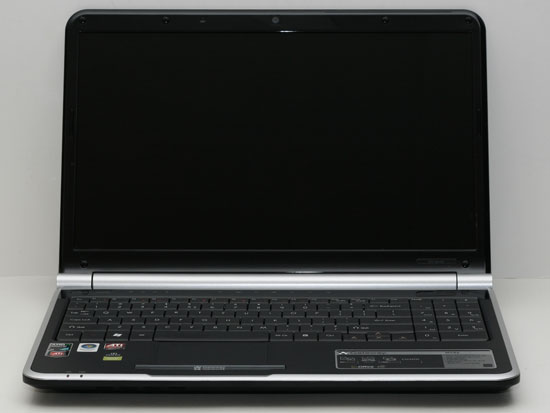 |
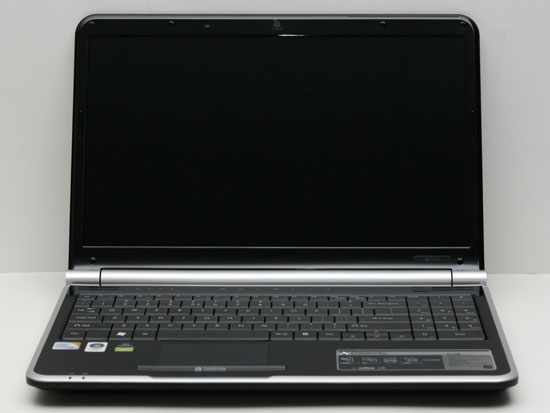 |
Here's a second look, focusing on the keyboards. Once again, AMD is above and Intel is below.
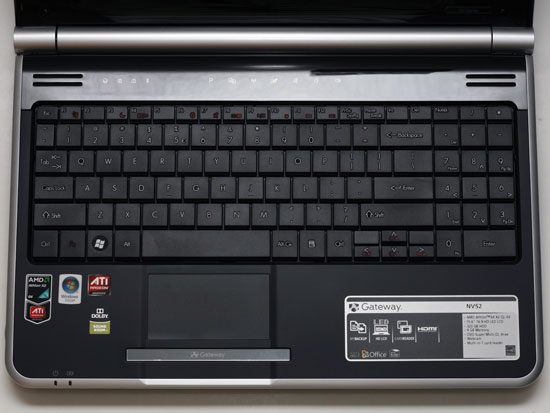 |
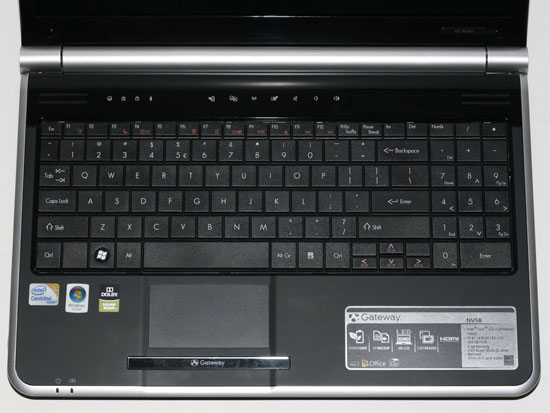 |
The chassis are identical from the outside, and everything else is the same as well other than the motherboard, chipset, and processor. Both come with 4GB DDR2 memory, a 15.6" 1366x768 LED backlit LCD, 320GB 5400 RPM hard drive, and a DVDRW. Both also include Gigabit Ethernet and 802.11n WiFi (Intel WiFi Link 5100 for the NV58 and Atheros AR928X for the NV52). In fact, even the CPUs have the same 2.1 GHz clock speed -- not that CPU clock speed matters -- as well as 35W TDP ratings -- not that that matters either, as we'll soon see. On the AMD side, we have the QL-64 (65nm, 2.1GHz, 2x512K L2, 3600MHz HyperTransport bus), and on the Intel laptop we have the T6500 (45nm, 2.1GHz, 2MB shared L2, 800MHz FSB). We should also mention that the NV58 costs more than the NV52, $500 for the NV52 and $580 for the NV58. What does the extra $80 buy you?
We will have performance numbers in our upcoming full review, but considering this is a match between AMD's old dual-core Athlon 64 X2 (K8 architecture) and Intel's Core 2 Duo, you can probably already guess the results. Intel is quite a bit faster in all of the CPU benchmarks. On the other hand, the AMD platform comes with much better integrated graphics, so if you would like to do a bit of 3D gaming on occasion (at low to medium detail levels) AMD easily wins the graphics benchmarks. Now let's look at battery life.










80 Comments
View All Comments
medi01 - Monday, August 10, 2009 - link
GPU is a couple of hundred percent faster.CPU is a couple of dozen percent faster.
Many people I know actually play games on their laptops.
JarredWalton - Monday, August 10, 2009 - link
It's about 100% faster on average... and tell me this: what's twice as fast as horribly slow? The fact is, even the ATI 780G HD 3200 IGP struggles mightily in most modern 3D titles. Far Cry 2, absolute minimum detail settings, gets 24FPS at 800x600 (or 16FPS at the native 1366x768). Assassin's Creed, minimum settings are the same (24FPS/15FPS at 800x600/1366x768). Need I mention that both of those games look like garbage at the minimum settings? Mass Effect: 11FPS at 800x600 (unplayable), and Riddick: Dark Athena is about the same (12.6FPS at 800x600).If you were to go out and purchase a laptop with a GeForce 9500M or Radeon HD 3650 level GPU, you'd be about three to four times as fast as the HD 3200. Then you can actually play games if you'd like, though you'll also have lower battery life. Considering about 90% of laptop users probably never do anything gaming related outside of Solitaire, I'd say they'd be far more interested in the $580 Intel system that is noticeably faster (30%) in many tasks and ALSO provides 30% more battery life.
MikosNZ - Thursday, August 6, 2009 - link
I hate to state the obvious but I see no mention of battery testing or the same battery being used for both laptops in these tests. Lithium ion batteries are notorious for large variances in electrical capacity due to both shelf life and batch. This could easily account for 20-30% PLUS variance. I have seen numbers easily around that when doing battery testing for commercial laptops. These tests are completely worthless unless the same battery was swapped between the two or the batteries used were separately tested to ensure equivalence. I would definitely not rely on gateway to QA their batteries to a level required for accurate platform testing.MikosNZ - Thursday, August 6, 2009 - link
Actually on second read there does seem to be some implicit references to this. Was this actually done after all?JarredWalton - Thursday, August 6, 2009 - link
Nope, but if it will make you feel better I'll swap batteries between the two and rerun one of the tests to check results. I'd wager less than a 2% difference but I could be wrong.... Check back tomorrow.JarredWalton - Thursday, August 6, 2009 - link
Swapping the batteries, the results stay essentially the same in the Idle battery test. With the original batteries, the Intel system has 20.25% more battery life. Switching the result was 19.57% better battery life.FWIW, both systems scored slightly lower after the battery swap - 230 vs. 242 on the AMD and 275 vs. 291 on the Intel system. All settings remained the same, but I started the tests right after the batteries hit 100% charge coming back up from 88% (they were sleeping and unplugged much of yesterday). If necessary, I can fully charge them and rerun the test, but a margin of error of around 2-3% is normal in battery tests when you don't short the discharge/charge cycle, and not fully discharging a battery will frequently result in less battery life on the next cycle.
lyeoh - Friday, August 7, 2009 - link
Thanks for doing that.While the result was not surprising, it was good to eliminate that.
Different batches of batteries have been known to perform differently (some even explosively ;) ).
It might be the AMD laptop's graphics system that's the power hog.
But whatever it is, it doesn't look good for AMD.
FWIW, some Macbooks seem to have rather good battery life, I wonder if they do any special tricks that the windows laptops don't.
JarredWalton - Friday, August 7, 2009 - link
They say MacBooks do some power saving "tricks" that don't use the standard ACPI interface or something. They also have better control over the OS/hardware, and OS X looks like it manages to stay in low-power C-states much better than any Windows OS.Jeffk464 - Thursday, August 6, 2009 - link
Is amd coming up with anything to compete with Intels new Ultra low voltage cpu. I'm thinking about going this route for my next laptop, coupled with led backlight display these systems are getting unreal batter life. Check out the acer timeline series, the only thing is there kind of slow getting the core 2 duo out.Zagor Tenay - Wednesday, August 5, 2009 - link
Battery life should not be a concern at all for most laptop users, because most people use their laptops at home. Their laptops are treated like a desktop, power cable attached at all times. (They say they prefer a laptop because it uses less space, there is no cable clutter etc.) So, what is the point in paying a higher price premium for an Intel laptop, because it has a longer battery life? The answer is plain and simple: There is no reason.